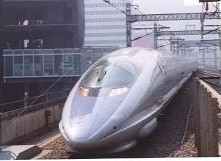 History of development, improvement and difficulties of this world famous high speed railway system.
Bullet train plan in 1940s The first plan to build new high-speed railway called Dangan Ressha (the Bullet Train) from Tokyo to Shimonoseki dates back to 1940. Construction began in 1941 and it was planned to complete in 1954. Its maximum speed was to be 150 kilometers per hour, and 200 kilometers per hour in the future. Journey time was 4 hours from Tokyo to Osaka, and 9 hours from Tokyo to Shimonoseki. At that time, it took 8 hours between Tokyo and Osaka by the fastest Limited Express eTsubamef by steam locomotive, maximum speed 95 kilometers per hour. They started to buy land and build some of the long tunnels, but due to the start of Pacific War, construction was stopped. However, those land and tunnels are used for Shinkansen after years. Decision to make new high speed railways After the defeat of war and severe situation all over the country, Japanese economy began to recover. Traffic of Tokaido line between Tokyo and Osaka, the two largest cities, began to increase rapidly and nearly reached to full capacity in mid 1950s. At that time, the idea of high speed railway was considered to be fantasy by many people. Practical idea at that time was four-tracking of existing Tokaido line, but the President of JNR insisted the building of new high speed rail, and Government finally supported the project. If simple four-tracking had been adapted, conventional Tokaido line of old railway system taking at least 6 hours between Tokyo and Osaka would have been completely defeated by air and highway which grew rapidly after 1960s, and the existence of France TGV and other high speed railways would be questionable. It could be said that one decision at that time changed the future of railway in Japan and many other countries. High speed train named Shinkansen (New main line) was began to be built in 1959, and 515 kilometersf new line was completed in 1964, only five years. Tokyo Olympic game was to be held in October 1964, so they planned to complete Shinkansen before that and hurried the construction. Basis of new Shinkansen train In 1956, Tokaido Line from Tokyo to Osaka and Kobe was all electrified and in 1958, new electric multiple units (EMUs) train, Limited express eKodamaf (Echo) by type 20 (type 151 later) began to run. Before the introduction of type 20, long distance train in Japan are mostly pulled by locomotive. Type 20 was quite innovative, run from Tokyo to Osaka in 6 hours and 30 minutes (6 hours and 50 minutes at first), one hour shorter than existing locomotive train, and also equipped with air cushion and air condition of all cars which was quite rare in Japan at that era. eKodamaf got quite successful and attracted many passengers because of its fast and comfortable journey. Now nearly all trains in Japan including Shinkansen are EMUs style, which is unique aspect in the world railways, but the successful eKodamaf was the origin of long distance Limited express EMU train, and became the basis of Shinkansen. Some part of the Shinkansen line between Kamonomiya and Oiso (Kanagawa Prefecture) opened in 1962 and experimental train began to run. It was opened to public through test drive and enhanced understanding of high speed railways to many people. It also revealed the problem of sudden change of air pressure when high speed train enters into tunnel, which shocks ears of passengers. This experience was reflected to practical train of air proof structure. Open of Shinkansen in 1964  After rush construction, Shinkansen finally opened in 1 October, 1964, ten days prior to the opening ceremony of Tokyo Olympic game.
After rush construction, Shinkansen finally opened in 1 October, 1964, ten days prior to the opening ceremony of Tokyo Olympic game. At that time, one fast eHikarif express which takes 4 hours from Tokyo to Shin Osaka and one eKodamaf express which stops all the station and takes 5 hours ran every hour. Maximum speed was 210 km/h but there were many temporary speed restrictions at first. In 1965, those restrictions were removed and trains got much faster, eHikarif was 3 hours and 10 minutes, eKodamaf was 4 hours. Train was called eType 0f with unique bonnet style like airplane. Train set was composed of 12 cars (later, 16 cars), two of them were first class cars (4 column seat, later called eGreen carf) and other ten were second class cars (5 column seat). There were two buffet equipments in train set. Shinkansen is completely different railway system from conventional railways, and there are many unique aspects. First, gauge of Shinkansen is 1,435 mm, while conventional railway in Japan is narrow 1,067 mm. So it is impossible to run through train from Shinkansen to other railway, and carriage of Shinkansen (3.38 meters width and 25 meters length) is larger than conventional cars (2.9 meters width and 20 meters length). Secondly, the minimum curve radius of Shinkansen was 2,500 meters, while 300 or 400 meters in existing railways. Thirdly, in order to operate high speed trains safely, Shinkansen track are all elevated, guarded by fences and strictly prohibited to enter into track. Fourthly, unlike conventional railways in which different type of trains such as limited express, local train, freight train run same track irregularly, train schedule of Shinkansen was quite simple. eHikarif departed Tokyo at 00 minutes, and eKodamaf at 30 minutes every hour. This idea, long distance trains run frequently and regularly like urban commuter train (such as every hour or every thirty minutes), was first introduced in Shinkansen and later other major rail lines in Japan. It became quite convenient for travelers and industry, business activity and tourism along Shinkansen route were enhanced. Fifthly, Shinkansen adapted innovative train operating system, ATC (Automatic traffic control system). There are no signals along Shikansen track, and the speed restriction is displayed in the monitor of the driverfs cab. If train does not keep that speed, train speed is automatically adjusted in order to avoid accident. Success and growth of Shinkansen Due to the fast and convenient service, Shinkansen got quite popular transport. Average number of passengers of Shinkansen was 21,649 in 1964, and grew at surprising pace, marking 20 or 30 percent increase every year in 1960s (27,738 in 1965, 49,681 in 1967, 70,807 in 1970). Train schedule was consequently improved. It was e1-1f pattern (one Hikari and one Kodama every hour) in 1964, e2-2f pattern in 1965, e3-3f pattern in 1967. Change of Tokaido Shinkansen Passengers In 1970, the World Exposition festival was held at Osaka. To cope with the increase of passengers due to the festival, eHikarif was changed from 12 cars set to 16 cars. 62 million people visited EXPO during six month, and 10 million of them used Shinkansen. Thanks to the growth of Japanese economy and income increase, and frequent, convenient service of Shinkansen, it changed from special, expensive transportation to familiar transportation which can be used easily like subway or bus. In 1970, Shinkansen Railway Construction Act was established and 7,000 kilometersf nationwide Shinkansen network plan was decided. But due to the lack of expense and other problems, construction was delayed. Tohoku and Joetsu Shinkansen opened in 1982 due to this Act, but other routes are not completed yet. Namely basic plan route of this Act seems to have little passengers and unrealistic, not worthy of large cost and seems not to be built any more except Chuo Shinkansen between Tokyo and Osaka. In 1972, Shinkansen was extended to Okayama, and in 1975, Hakata (Fukuoka) in Kyushu Island. Alough new western part, Sanyo Shinkansen, has fewer passengers than Tokaido, Shinkansen contributed to the growth of industry and tourism along the line. Since 1975, due to the longer distance, dining car was included in eHikarif train set. New Sanyo section has better facility than Tokaido part. Tokaido Shinkansen used conventional ballast track, but Sanyo Shinkansen, especially Okayama - Hakata section mainly used slab track, which is made of concrete track bed and easier to be maintained. Minimum curve radius of Sanyo Shinkansen is 4,000 meters, larger than 2,500 meters of Tokaido Shinkansen, and has advantage in running faster in the future. 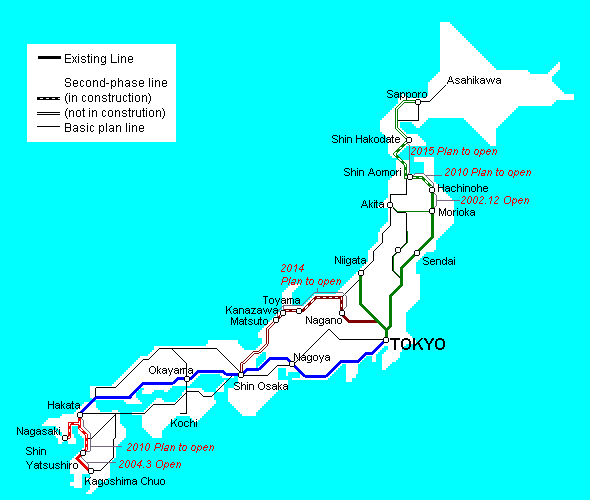 Difficult years of Shinkansen Shinkansen made remarkable success during 1960s with increasing passengers, but it also had some problems and difficulties later. Environment problem regarding train noise became quite serious in Shinkansen, which runs through urban area. In 1974, lawsuit was brought against train noise by Nagoya citizens along Shinkansen line, and they demanded the restriction of noise level less than 65 phones and speed reduction. In 1975, Ministry of Environment set standard of noise, less than 70 phones in residential area. JNR and JR have taken measures such as making noise reduction wall along railway, reducing pantograph and making the surface of train smoother. Lawsuit finally ended in 1986, and Japan National Railway promised to take effort in further reduction of noise keeping environmental standard and made compensation. It is difficult for Shinkansen to speed up because this noise standard has to be kept. Besides, passengers of Shinkansen turned to decrease in late 70fs. It was mainly due to the development of air and road transport and heavy deficit of Japanese National Railway. In Japan, improvement of air and road had been slow compared with U.S and Western Europe, and railway had kept the most important position in transport system until 1960s. But due to the introduction of large jet and improvement of airport, air travel became relatively cheaper and frequent services were introduced to many cities. Also highway and new bypass road had been constantly extended and people came to do commuting, shopping and all other tasks by driving their car especially in rural area. Shinkansen extended to western Japan in 1970s, but from Tokyo to Hiroshima or Fukuoka, air is faster than Shinkansen, so especially in west Okayama - Hakata section, passengers got much fewer than eastern part. Besides, because of the development of other transport, inefficient management, tendency to be affected by rights of politics and other reasons, JNR suffered from serious deficit, and they raised train fare almost every year during late 70s and early 80s, which leaded to decrease of passengers. In addition, deficit and lack of investment stopped improvement of Shinkansen service. Nearly same type 0 train had been produced since 1964 to 1985, and train speed had been same during that period, either. Change of Tokaido Shinkansen Passengers Open of Tohoku and Joetsu Shinkansen 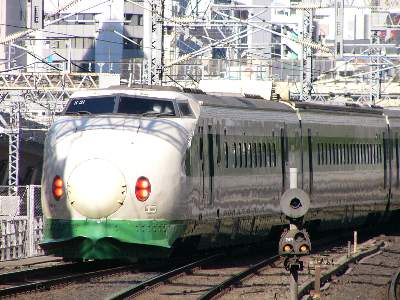 In 1982, Tohoku Shinkansen (Omiya - Morioka) and Joetsu Shinkansen (Omiya - Niigata) was opened. As it was difficult to get estate in urban area, they departed Omiya, northern suburbs of Tokyo at first. Those two new Shinkansen run through northern region and it snows a lot in winter. So sprinkler to distribute a lot of hot water is introduced in Joetsu Shinkansen, and newly produced type 200 train set are designed to cope with cold weather, equipped with snow plough and centrifuge to cut snow when outer air comes into carriages and machines. Another advantage of type 200 is that it adapts lighter aluminum vehicle body.
In 1982, Tohoku Shinkansen (Omiya - Morioka) and Joetsu Shinkansen (Omiya - Niigata) was opened. As it was difficult to get estate in urban area, they departed Omiya, northern suburbs of Tokyo at first. Those two new Shinkansen run through northern region and it snows a lot in winter. So sprinkler to distribute a lot of hot water is introduced in Joetsu Shinkansen, and newly produced type 200 train set are designed to cope with cold weather, equipped with snow plough and centrifuge to cut snow when outer air comes into carriages and machines. Another advantage of type 200 is that it adapts lighter aluminum vehicle body. Thanks to those facilities, Tohoku and Joetsu Shinkansen operate smoothly in severe weather condition in winter. Conventional Joetsu line had suffered from snow in winter and trains were often delayed or stopped, so Shinkansen improves reliability of transportation during winter. In 1985, Tohoku Shinkansen extended to Tokyo Ueno terminal. At that time, maximum speed of Tohoku and Joetsu Shinkansen was raised from 210 km/h to 240 km/h. In 1991, Tohoku Shinkansen between Tokyo and Ueno was opened, and accessibility from business and commercial center was improved. Improvement of Tokaido and Sanyo Shinkansen In 1986, new type 100 was introduced to Tokaido and Sanyo Shinkansen. It had two double-decked cars in 16 cars train set, which had individual cabin of Green car (first class) and dining car (cafeteria in later version). Seats of standard class cars were also improved, and distance between seats were extended from 98 cm (type 0) to 104 cm, and comfortable facility attracted many passengers. Maximum speed was 220 km/h, 10 km/h faster than type 0, and it was 2 hours and 52 minutes from Tokyo to Shin Osaka which was faster than 3 hours and 10 minutes of type 0. In 1987, to cope with debt problem of JNR, it was finally privatized and separated by region to seven companies, JR (Japan Railways). As private company to pursue profit, JR pays effort to improve Shinkansen service, and tries to recover passengers from air service. Type 0 had been replaced by type 100 quickly, and in 1992, new type 300 was introduced.
Extension of Shinkansen network by eMini Shinkansenf In 1992, Yamagata Shinkansen between Fukushima and Yamagata, the branch line of Tohoku Shinkansen, was opened. This section was not newly constructed, but the gauge of conventional line was widened from 1067mm to 1435mm, and Shinkansen can go direct from Tokyo to Yamagata, which is called eMini Shinkansenf. Type 400 introduced to Yamagata Shinkansen is smaller than other Shinkansen vehicle to adapt to the standard of conventional railway. eMini Shinkansenf connects Tokyo and country city which does not have large traffic enough to build new Shinkansen directly with relatively small cost. eTsubasaf express began to run between Tokyo and Yamagata. It is 6 cars (later 7 cars) type 400 train set, and conveyed with eYamabikof (Tokyo - Sendai) between Tokyo and Fukushima. In 1997, the second eMini Shinkansenf was opened between Morioka and Akita, and type E3 was introduced to this Akita Shinkansen. And Yamagata Shinkansen extended to Shinjo in 1999.  Type E3 'Komachi' leaves Tokyo, conveyed with E2 'Hayate'. In the same year, Nagano Shinkansen between Takasaki and Nagano was completed. This is newly built line and not eMini Shinkansenf. In that year, Winter Olympic game was held at Nagano, which is important reason for the completion of this Shinkansen. Type E2 was introduced to Nagano Shinkansen, and maximum speed was 260 km/h. In 2002, Tohoku Shinkansen was extended from Morioka to Hachinohe, and new eHayatef express was introduced using fast type E2 train set. In 2004, south part of Kyushu Shinkansen between Shin Yatsushiro and Kagoshima Chuo are going to open, introducing type 800 which is based on type 700 'Hikari Railstar' and maximum speed 260 km/h. Until Hakata- Shin Yatsushiro section completes in 2013, Kyushu Shinkansen exists independently without through service from Osaka. Change of Tohoku and Joetsu Shinkansen after privatization 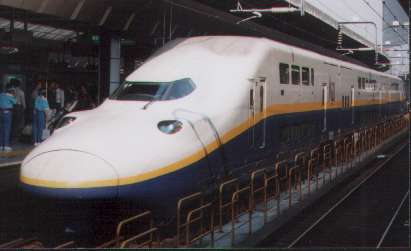 One notable change of Tohoku and Joetsu Shinkansen is the measures taken for commuter demand. Shinkansen is mainly for long distance travelers, but due to the extension of Tokyo suburban area, more passengers come to use Shinkansen to everyday commuting. In order to relieve congestion in morning and evening, type E1, all double-decked 12 cars train set, was introduced in 1994. In 1997, type E4, all double-decked 8 cars train set, was introduced. Putting two sets together, type E4 can be used as 16 cars train with 1,634 seat capacity, about 40 percent larger than single-decked 16 cars train. This train is called eMaxf and 1,634 seat capacity is the largest in the world railways.
One notable change of Tohoku and Joetsu Shinkansen is the measures taken for commuter demand. Shinkansen is mainly for long distance travelers, but due to the extension of Tokyo suburban area, more passengers come to use Shinkansen to everyday commuting. In order to relieve congestion in morning and evening, type E1, all double-decked 12 cars train set, was introduced in 1994. In 1997, type E4, all double-decked 8 cars train set, was introduced. Putting two sets together, type E4 can be used as 16 cars train with 1,634 seat capacity, about 40 percent larger than single-decked 16 cars train. This train is called eMaxf and 1,634 seat capacity is the largest in the world railways. Tohoku Shinkansen got faster in 1997, maximum speed was raised from 240 km/h to 275 km/h using newly introduced type E2. It was mainly due to the competition with air between Tokyo and Akita. Train bound for Sendai and Niigata is not so fast because they are close to Tokyo and there is no competition with air.  Future of Shinkansen Shinkansen will be faster in the future using new vehicle. In Tokaido and Sanyo Shinkansen, new type 700X vehicle will be produced in 2005, and planned to be in service in 2007. Maximum speed of type 700X is said to be same 300 km/h at this moment, but tilting system by air cushion are introduced, and train runs curve of 2,500 meters radius of Tokaido Shinkansen, currently running at 250 km/h, at 270 km/h. Acceleration rate is also improved, 2.6 km/h/s, better than 1.6 km/h/s of current type 700 in Tokaido Shinkansen. It will be several minutes faster from Tokyo to Osaka by type 700X. Speed-up is also considered in Tohoku Shinkansen. In 2013, Tohoku Shinkansen will extend to Shin Aomori, and in order to connect Tokyo and Aomori within 3 hours to win competition with air services, JR East plans to raise maximum speed over 300 km/h. As the map shows, Shinkansen network is extending further. Tohoku Shinkansen to Aomori, Kyushu Shinkansen between Hakata and Kagoshima, and Hokuriku Shinkansen from Nagano to Toyama will complete till 2013. Shinkansen might be extend to other cities such as Sakata, Matsue, Takamatsu, Matsuyama and Oita by introduction of eMini Shinkansenf or the development of free-gauge train currently under experiment which can change gauge from 1435 mm to 1067 mm and go direct from Shinkansen to conventional rail line. Another future project is the development of linear motor car, more than 500 km/h maximum speed between Tokyo and Osaka by way of Chuo Shinkansen route. Part of experimental linear motor car line was completed in Yamanashi in 1997, and it is said to be possible to use as practical transport despite some problems such as cost and durability remain. However, it requires so expensive cost, and considering the current situation that Shinkansen traffic between Tokyo and Osaka is not increasing, there is not urgent necessity at this moment to build another new linear motor car line. |

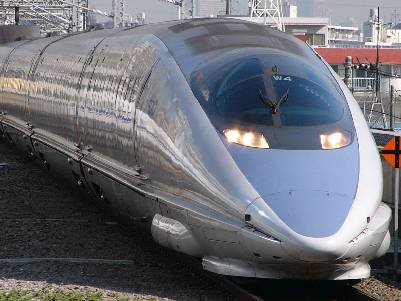
 In 1999, type 700 was introduced and now occupies most of eNozomif services. Its maximum speed is 285 km/h, slightly slower than type 500, but it is cheaper and more comfortable than type 500. It does not use circular style body which is good for ultra high speed running but makes passengers space smaller, so type 700 looks normal compared with type 500. Type 700 put emphasis not only on speed, but also balance with other aspects such as cost, efficiency and amenity.
In 1999, type 700 was introduced and now occupies most of eNozomif services. Its maximum speed is 285 km/h, slightly slower than type 500, but it is cheaper and more comfortable than type 500. It does not use circular style body which is good for ultra high speed running but makes passengers space smaller, so type 700 looks normal compared with type 500. Type 700 put emphasis not only on speed, but also balance with other aspects such as cost, efficiency and amenity. 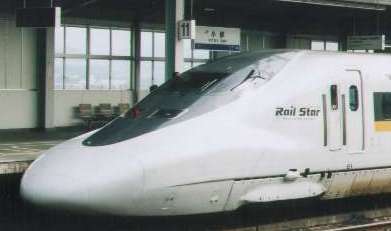 JR West introduced eHikari Railstarf service in 2000, which uses special comfortable version of type 700 of short 8 car train set equipped with 4 column seat in standard class (5 column in existing car), compartment type car and office seat which is good for use of personal computer, and recovers passengers of Sanyo Shinkansen.
JR West introduced eHikari Railstarf service in 2000, which uses special comfortable version of type 700 of short 8 car train set equipped with 4 column seat in standard class (5 column in existing car), compartment type car and office seat which is good for use of personal computer, and recovers passengers of Sanyo Shinkansen.